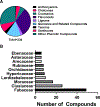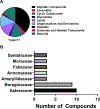Ethnobotany and the Role of Plant Natural Products in Antibiotic Drug Discovery
- PMID: 33164487
- PMCID: PMC8183567
- DOI: 10.1021/acs.chemrev.0c00922
Ethnobotany and the Role of Plant Natural Products in Antibiotic Drug Discovery
Abstract
The crisis of antibiotic resistance necessitates creative and innovative approaches, from chemical identification and analysis to the assessment of bioactivity. Plant natural products (NPs) represent a promising source of antibacterial lead compounds that could help fill the drug discovery pipeline in response to the growing antibiotic resistance crisis. The major strength of plant NPs lies in their rich and unique chemodiversity, their worldwide distribution and ease of access, their various antibacterial modes of action, and the proven clinical effectiveness of plant extracts from which they are isolated. While many studies have tried to summarize NPs with antibacterial activities, a comprehensive review with rigorous selection criteria has never been performed. In this work, the literature from 2012 to 2019 was systematically reviewed to highlight plant-derived compounds with antibacterial activity by focusing on their growth inhibitory activity. A total of 459 compounds are included in this Review, of which 50.8% are phenolic derivatives, 26.6% are terpenoids, 5.7% are alkaloids, and 17% are classified as other metabolites. A selection of 183 compounds is further discussed regarding their antibacterial activity, biosynthesis, structure-activity relationship, mechanism of action, and potential as antibiotics. Emerging trends in the field of antibacterial drug discovery from plants are also discussed. This Review brings to the forefront key findings on the antibacterial potential of plant NPs for consideration in future antibiotic discovery and development efforts.
Conflict of interest statement
The authors declare no competing financial interest.
Figures







References
-
- CDC “Antibiotic Resistance Threats in the United States, 2019 ” U.S. Department of Health and Human Services, 2019.
-
- Durand GA; Raoult D; Dubourg G Antibiotic Discovery: History, Methods and Perspectives. Int. J. Antimicrob. Agents 2019, 53, 371–382. - PubMed
-
- Årdal C; Balasegaram M; Laxminarayan R; McAdams D; Outterson K; Rex JH; Sumpradit N Antibiotic Development — Economic, Regulatory and Societal Challenges. Nat. Rev. Microbiol 2020, 18, 267–274. - PubMed
-
- Harvey AL; Edrada-Ebel R; Quinn RJ The Re-Emergence of Natural Products for Drug Discovery in the Genomics Era. Nat. Rev. Drug Discov 2015, 14, 111–129. - PubMed
Publication types
MeSH terms
Substances
Grants and funding
LinkOut - more resources
Full Text Sources
Medical
Molecular Biology Databases

